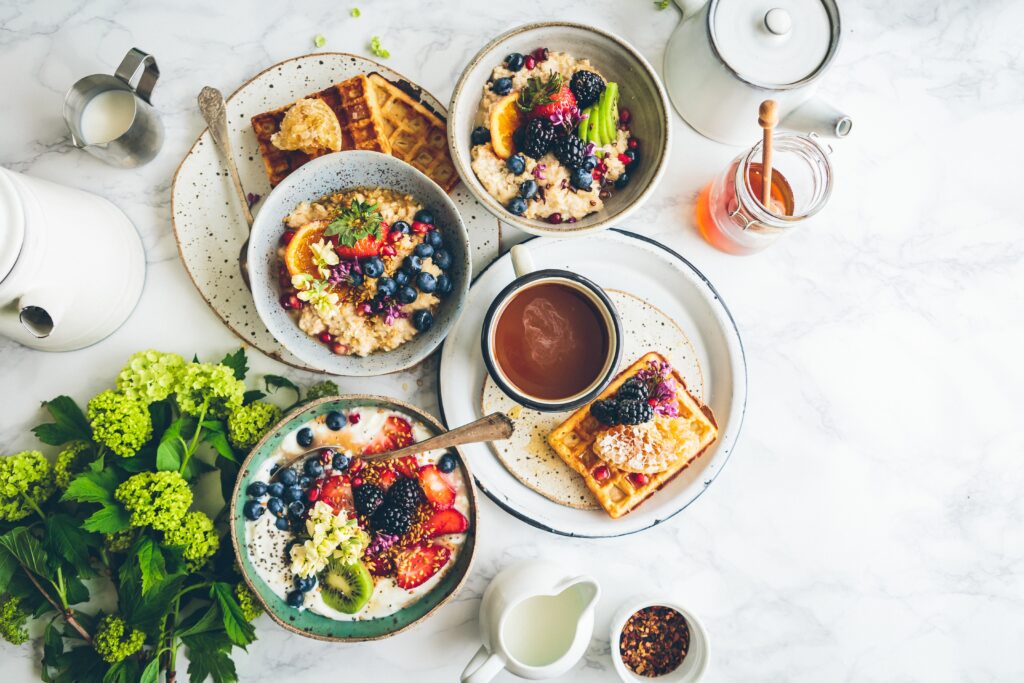Meal prep can be a real mental hassle. Whether you are looking to get started with meal prep or new meal prep ideas to make your meal prepping more fun, I’m happy to share some useful meal prep hacks to optimise your time in the kitchen while enjoying satisfying and nutritious meals.
It can even help you on your journey to become an intuitive eater. Whether you’re a super busy professional, a student, or a parent, meal prepping can simplify your life and help you stay on track with your nutritional goals. While most meal prep posts focus on batch cooking a single meal in multiple portions for an entire week, I favour a more intuitive and flexible approach—because meal prep should not become a mental hassle!
1. Batch-Shopping
Effective meal prep starts with effective shopping. Let me show you how to shop, and you’ll see how easy it is.
Once you’re at the supermarket:
Divide and conquer
Divide your trolley into three parts (use carry bags for that—it’s better for the environment, too).
Have one small compartment for fun food, too! We are intuitive eaters after all.
Most supermarkets follow this principle, and you can shop for each compartment without walking your 10,000 steps, unless you want to, of course.
For each compartment, buy what you feel like, and what looks good to you.

a. Fruits and vegetables
I suggest going for seasonal varieties. Make sure you buy fresh herbs as well. If you really don’t have time for chopping and preparing, go for frozen veggies and fruits—just make sure to bring a cooler bag.
b. Carbohydrates
Pasta, rice, quinoa, potatoes, bread, and beans. Opt for some items you can store for long as well as fresh items. You can also freeze these!
c. Proteins
Chicken, tofu, red meat, eggs, fish, yoghurt, cottage cheese, and cheese.
d. Fats
Avocado, seeds, olive oil, butter, ghee, etc.
e. Fun food
Both sweet and savoury. These usually store well for a few weeks. Just make sure this is the smallest compartment of your trolley.
Always check use-by dates and buy items with a wide range of dates.
You can keep zucchinis, bell peppers, and eggplants much longer than salads and herbs—keep that in mind when cooking! You can check how long different foods stay fresh over here.
Ensure you have good quality containers at home. Prefer glass to plastic, especially for veggies, as they tend to absorb smells.
Also, stock up on toppings and condiments (seeds, spices, savoury granola, peanuts, nuts, soy sauce, lemon, honey, mustard, etc.).
Choose versatile ingredients that can be used in multiple dishes. For example, roast a whole chicken and use it for salads, sandwiches, and soups.
2. Batch Cooking – My Style
Batch cooking involves preparing large quantities of food at once and then dividing them into portions for the week. This method is perfect for those who prefer to cook once and enjoy meals throughout the week without having to cook every day. It’s an excellent way to ensure you have nutritious meals ready to go, especially during busy workweeks.
- Benefits: Time-saving, cost-effective, and reduces food waste.
- Stats: According to a study published in the American Journal of Preventive Medicine, individuals who cook at home consume fewer calories and are more likely to have a healthier diet overall.
Instead of following a recipe and cooking lots of it, my kind of batch cooking relies on these principles:
- Intuition: I don’t know about you, but I don’t know what I’ll feel like eating next Friday, so I need my “meals” to be versatile and swappable.
- Time: I want to spend minimal time in the kitchen. I need my meals to be ready quickly, and I want to maximise my time while I’m actually in the kitchen.
- Planning: I don’t carry my recipe book when shopping, nor do I have the time to add up ingredients from multiple recipes and shop accordingly. Too much thinking involved. That’s why I like this style of batch cooking:
How to batch cook?
Allocate 2x 1-hour sessions per week to prepare food:
- Wash, cut, and cook or grill vegetables in the oven.
- Meanwhile, boil some carbs (pasta, rice, quinoa, bulgur, beans if not canned) in the desired quantities, depending on whether you have a family to feed or if it’s just you.
- Also, grill or boil your 2-3 sources of protein.
- While all this is cooking, wash and cut herbs (parsley, coriander, spring onions, sprouts, etc.) and store them fresh.
- Wash and store fruits you would use for your main dishes (pomegranate, grapes, etc.).
Once everything is cooled down, store it in airtight containers in the fridge to keep them fresh.
You now have a “batch buffet” ready to mix and match for a few days.

3. How to Create Intuitive and Satisfying Meals
Have you ever been to a salad or poke bar? Why not use the same system at home?
Take a bowl or a plate. If you have a family, just put everything out on the table. It might even be fun to see the dishes everyone is preparing for themselves.
- Choose a carb base (rice, pasta, quinoa, bread, rice noodles, etc.).
- Choose 1-2 vegetables as a green base.
- Add a protein.
- Add a fat (oil, avocado, etc.).
- Add seasoning and spices.
- Add a crunch (salty granola, nuts, or seeds).
- Add a sweet touch if you like (apple, cranberries, pomegranate, grapes, etc.). This will help curb sweet cravings later.
Heat it up or eat it cold, and enjoy!
4. Pimp-Up Your Leftovers
Sometimes creativity comes when you have fewer options.
There’s so much you can do with food while ensuring nothing goes stale. Here are some fun ideas:
- Use your grilled vegetables in a quiche or frittata.
- Transform your leftover bread into pan-fried chilli breadsticks or gazpacho.
- Your boiled potatoes can be pan-fried or turned into a salad.
- Your pasta can be transformed into a creative pasta bake.
- Fish, meat, or eggs can be added cold to a delicious sandwich.
Did you know that Fattoush, Paella, Tortilla, Chilaquiles and many other famous dishes originated from leftovers?
5. The Right Meal Prep Tools
Technology can be a make-or-break deal in meal prepping. Apps and gadgets are designed to make meal planning and preparation more manageable than ever. From smart refrigerators that help track inventory to mixers that enable hands-free cooking, you can multitask in the kitchen, too!
Ensure you have the right tools in the kitchen: good quality knives, a big chopping board, and a mixer that can mix without you holding it. The more your tools can “work” by themselves, the more chances you have to multi-task and make the most of your allocated time in the kitchen.
6. Freezing and Storing your food
Besides buying frozen items (you can even buy frozen chopped onions!), freezing is an excellent way to preserve meals for longer periods, allowing you to enjoy home-cooked meals even on the busiest days. Proper storage is key to maintaining flavour and nutritional value.
- Benefits: Reduces food waste and extends the shelf life of meals. Check out the shelf life of different food items.
- Tips: Invest in quality freezer-safe containers and label everything with the date of preparation.
7. Focus on Nutrition
Intuitive meal prep is an excellent way to ensure you’re providing as many nutrients as possible to your body. By buying by food groups, you’re ensuring your body gets everything it needs. Here are some tips on how to ensure you’re not eating the same things repeatedly:
- Opt for seasonal fruits and vegetables—this way, you’re eating in sync with what your body needs, the weather, and your location.
- Buy local as much as you can—fresh food that travels less retains more nutrients.
- Add superfoods and go for ingredients that will keep you full longer (whole wheat, brown rice, chia seeds, etc.).
- Make sure you include all food groups in your meals.

8. But Don’t Forget Satisfaction
When we meal prep, our first thought is often to prepare super-healthy meals. We start with the best intentions, but these meals can end up being so healthy that we risk having post-meal sweet cravings and feeling unsatisfied. Here are some tips to make your meals nutritious and satisfying, so you’re left wanting nothing more afterwards:
- Be mindful to include different textures: soft, creamy, and crunchy.
- It’s all about the toppings! Spices, seeds and nuts, salty granola, fruits, or even tortilla chips can level up the satisfaction of your dish. Adding something sweet will curb post-meal cravings.
- Make sure not to repeat your meals too often to avoid “meal fatigue.”
- Go for themed weeks—this way, you’ll avoid “meal prep fatigue” and might learn a thing or two about foreign cuisines.
9. Meal Prep Containers
Having the right meal prep containers will make it way more fun to prepare food ahead of time. As with your kitchen utensils or tools, having easy-to-use containers that you can stack in the fridge is a game changer in your meal-prepping journey.
10. Leave Room for Flexibility and Spontaneity
With meal prep, leave some options and flexibility for eating out or family meals. You wouldn’t want to say no to a spontaneous invitation for dinner or brunch just because “you’ve got food at home.” Be flexible with your planning.
Another piece of advice is to make sure you have something ready to eat or heat up on those days when you know you’ll be super busy. Knowing something’s ready to eat at home can significantly reduce overeating and snacking before meals. You’re removing the idea of scarcity, which can feel safe and comforting.

Conclusion
Meal prep is a breeze if you keep it simple and practice a few times. I suggest not setting the bar too high for yourself—start small. Don’t try to cook a three-course Michelin-star meal in the first week.
Once you get the hang of it, it’ll become a fun and relaxing ritual. You can even put on some music, and while everything is grilling, boiling, and cooking, why not relax with a book or do some exercise?
By incorporating these top 10 meal prep strategies, you can enjoy nutritious and delicious meals throughout the week while making the most of your resources and time. Bon appétit!

